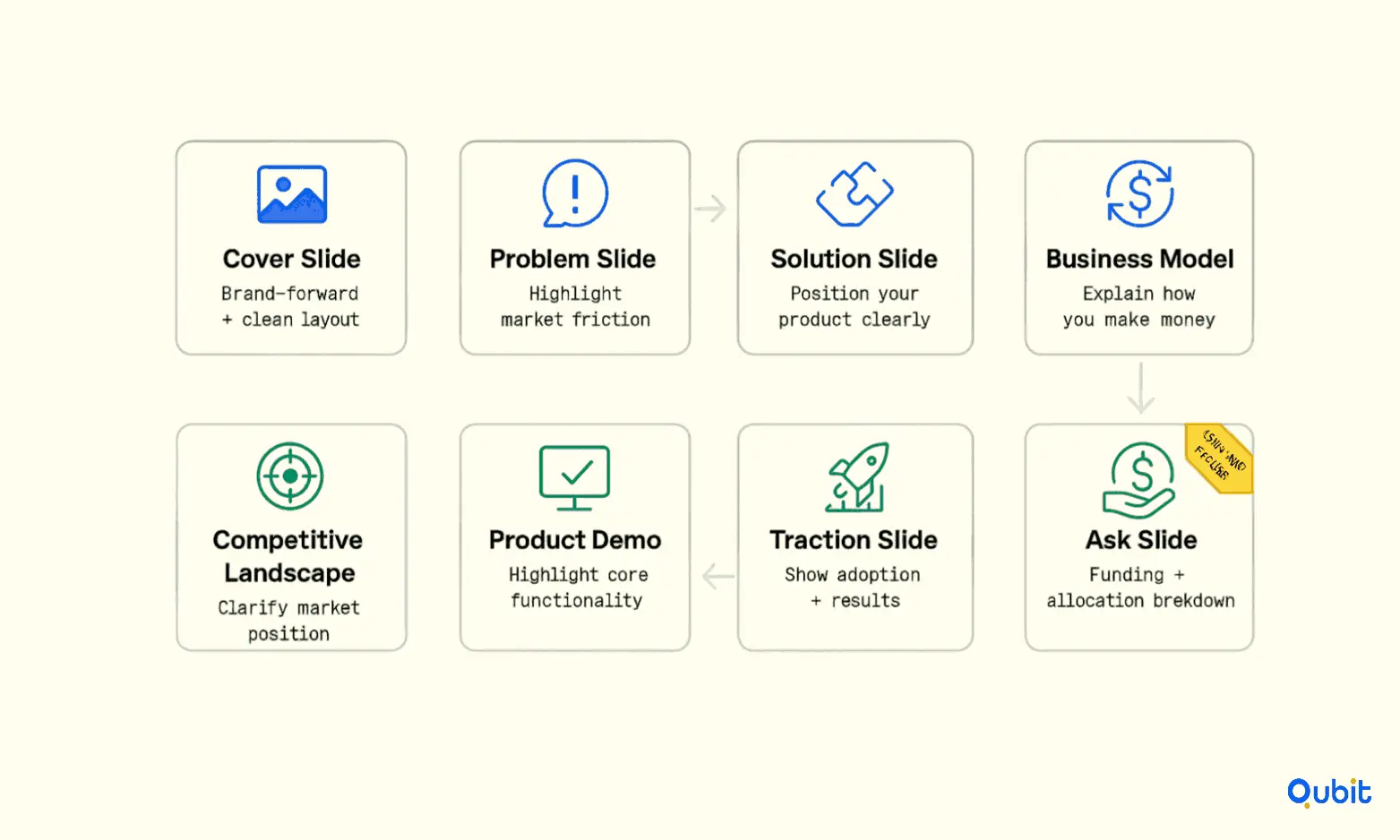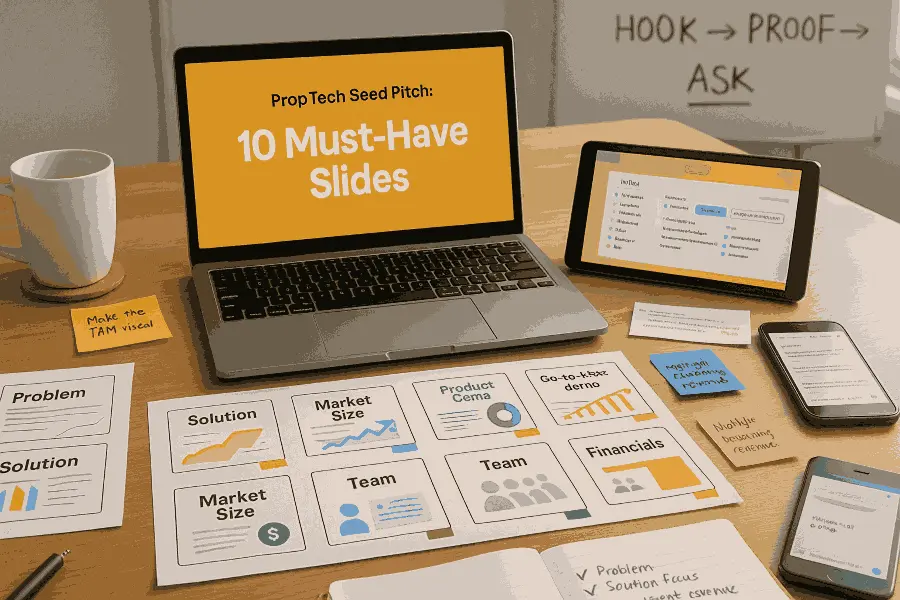Securing seed-stage funding in the competitive PropTech sector requires more than just a great idea—it demands a pitch deck that tells a compelling story. This guide is designed to help you craft a winning PropTech pitch deck by outlining the ten essential slides investors expect to see. Each slide plays a critical role in showcasing your vision, market opportunity, and growth potential.
Your pitch deck strategy finds a wider context in the proptech fundraising guide, which maps out the entire fundraising journey from seed to Series B. Whether you're refining your narrative or building your deck from scratch, this blog will provide actionable insights to help you stand out.
Let’s dive into the must-have slides that can make or break your pitch.
Why a Strong Pitch Deck Matters
A well-crafted pitch deck can be the difference between securing investor interest and being overlooked. For PropTech startups, a strong pitch deck not only highlights innovation but also establishes credibility, making it a cornerstone of investor evaluation.
Every Slide Tells a Story
Investors often assess pitch decks based on clarity, market differentiation, and the overall narrative. Each slide should contribute to a cohesive story that demonstrates your startup’s potential to solve real-world problems. A cluttered or poorly designed deck can dilute your message, while a polished presentation ensures your ideas resonate.
Building Trust Through Design
A professional pitch deck reflects the seriousness of your venture. Investors are more likely to trust a startup that presents its vision with precision and confidence. From market analysis to financial projections, every detail matters in showcasing your preparedness and strategic thinking.
The Competitive Edge
In the fast-paced PropTech sector, differentiation is key. A compelling pitch deck not only captures attention but also sets your startup apart from competitors. Highlighting unique value propositions and market opportunities can make your presentation memorable, increasing the likelihood of investment.

Compelling Cover Slide
To create a standout cover slide, simplicity is key. Avoid clutter and focus on a clean, high-quality design that reflects your brand identity. Minimal text paired with a striking visual or your company logo can communicate professionalism without overwhelming the viewer. This approach ensures that your audience is drawn in without being distracted by unnecessary details.
Additionally, the visual tone of the cover slide should align with the overall theme of your presentation. Whether you’re emphasizing innovation, sustainability, or cutting-edge technology, the design elements—such as color schemes, typography, and imagery—should reinforce your message. For example, a PropTech pitch deck might incorporate sleek, modern visuals to highlight technological sophistication.
Problem Statement Slide
For many property owners, managers, and tenants, the real estate market is riddled with inefficiencies that create frustration and financial strain. From outdated property management systems to the lack of transparency in transactions, these pain points have long been a barrier to seamless operations and customer satisfaction.
Property owners often grapple with fragmented tools that fail to provide a unified view of their assets, leading to missed opportunities and increased operational costs. Meanwhile, tenants face challenges such as delayed communication, unclear processes, and limited access to real-time updates. These inefficiencies not only erode trust but also hinder the overall experience for all stakeholders involved.
The PropTech industry has identified these gaps, yet many existing solutions fall short of addressing the root causes. They either overcomplicate processes or fail to integrate with modern technologies, leaving users stuck with partial fixes. This disconnect highlights the urgent need for a comprehensive, user-centric approach that bridges these gaps effectively.
Solution Slide
The solution works by combining data-driven insights with compelling storytelling techniques, ensuring your audience understands not just the "what" but also the "why" behind your product or service. By focusing on clarity and relevance, we help you articulate how your solution directly tackles market pain points, whether it's streamlining property management or enhancing investor decision-making.
What sets our solution apart is its emphasis on differentiation. Unlike generic pitch decks, our approach integrates tailored narratives that resonate with investors and stakeholders. A deeper look at narrative techniques is provided by the proptech data storytelling investors piece, which explores ways to transform property insights into a compelling investor narrative. This ensures your presentation stands out in a competitive landscape, positioning your offering as the obvious choice.
Market Opportunity Slide
The PropTech industry is experiencing unprecedented growth, presenting a lucrative opportunity for innovators and investors alike. With the global proptech market projected to reach USD 179.03 billion by 2034, driven by a robust 16% compound annual growth rate (CAGR) from USD 40.58 billion in 2024, the sector is poised for transformative expansion. This growth underscores the increasing demand for technology-driven solutions in real estate, property management, and construction.
Regional Growth Insights
In the United States, the PropTech market is expected to grow at a steady 13% CAGR through 2029, reaching USD 18,424.1 million by 2028. This regional growth highlights substantial opportunities for startups and established firms to capitalize on emerging trends, such as digital property transactions and AI-powered management tools. Investors seeking regional opportunities can benefit from this upward trajectory, as it signals strong market demand and scalability potential.
Funding Trends and Investor Confidence
Funding activity further validates the sector’s promise. As of October 2024, the median PropTech funding per company stood at $14.8 million, with $2.2 billion raised across 65 deals. Notably, Series B funding rounds dominate the landscape, reflecting investor confidence in scalable solutions and market validation.
Sustainability as a Key Driver
Another compelling trend is the rise of sustainability-focused PropTech solutions. Approximately 57% of PropTech firms in real estate management prioritize clean energy innovations, aligning with growing ESG (Environmental, Social, and Governance) investment interests. This shift not only addresses environmental concerns but also attracts investors committed to sustainable growth.
The data and trends presented here emphasize the immense market opportunity for PropTech solutions, making it a pivotal focus for businesses and investors aiming to thrive in this dynamic sector.
Business Model Slide
A well-structured business model slide is essential for demonstrating financial sustainability and scalability. This section highlights how the company generates revenue, manages costs, and plans for growth.
Revenue streams are the backbone of any business model. For PropTech companies, these may include subscription-based services, transaction fees, or licensing agreements. Each revenue source is designed to align with customer needs while ensuring consistent cash flow. On the cost side, expenses such as technology development, marketing, and operational overhead are anticipated and strategically managed to maintain profitability.
Scalability is another critical aspect of the business model. By leveraging technology and automation, PropTech businesses can expand their services without proportionally increasing costs. This scalability ensures that as the customer base grows, the company can maintain or improve its profit margins.
Competitive Landscape Slide
This slide delves into the strengths and weaknesses of competitors while identifying untapped opportunities that your company can capitalize on.
Analyzing Competitors and Market Gaps
A thorough analysis of competitors reveals not only their market share but also their strategies, customer base, and product offerings. By examining these factors, startups can pinpoint areas where competitors fall short—whether it’s in customer experience, pricing, or innovation. Identifying these gaps provides a roadmap for differentiation and growth.
What Sets Your Startup Apart
Highlighting your unique differentiators is the cornerstone of this slide. Whether it’s a groundbreaking technology, a customer-centric approach, or unmatched scalability, these elements should be emphasized to showcase why your company is the preferred alternative. For instance, if your PropTech pitch deck includes features that streamline property management in ways competitors cannot, this is the moment to spotlight that advantage.
Product Demo or Features
A well-executed product demo can transform curiosity into confidence. Our PropTech solution is designed to simplify property management, and this section highlights its standout features through a practical demonstration.
Key Features at a Glance
- Intuitive Dashboard: The user-friendly interface ensures seamless navigation, enabling property managers to access critical data effortlessly.
- Automated Reporting: Generate detailed reports in seconds, saving time and reducing manual errors.
- Real-Time Analytics: Stay informed with live updates on property performance metrics, empowering data-driven decisions.
Bringing the Product to Life
Imagine a property manager juggling multiple tasks—our demo showcases how the platform streamlines operations. From scheduling maintenance to tracking tenant inquiries, every feature is designed to enhance efficiency. The live demonstration also highlights customization options, ensuring the platform adapts to unique business needs.
Interactive elements, such as clickable modules and scenario-based walkthroughs, keep the audience engaged. This hands-on approach not only demonstrates functionality but also builds trust in the product’s capabilities.
Traction Slide
Highlighting measurable success is crucial for building investor confidence. The traction slide serves as a snapshot of your startup’s achievements, combining key metrics, milestones, and customer testimonials to demonstrate market validation.
Key Metrics and Milestones
- Customer Adoption: Rapid growth in user base, with a 30% increase in active users over the past quarter.
- Revenue Growth: Achieved a consistent 20% month-over-month revenue increase, showcasing scalability.
- Partnerships: Secured collaborations with industry leaders to expand market reach.
Case Studies
- Vacasa's 3D Technology Implementation: Vacasa integrated Matterport's immersive 3D technology to enhance property bookings while reducing operational costs. This example underscores the effectiveness of tech-driven solutions in scaling operations.
- Opendoor's Algorithmic Pricing Model: Opendoor developed an Automated Valuation Model for instant home pricing, which played a pivotal role in securing a $10 million Series A funding round in 2014. This case highlights the potential of scalable tech solutions in PropTech pitch decks.
Customer Testimonials
Positive feedback from early adopters further validates the product-market fit. Testimonials emphasize ease of use, cost savings, and transformative results, reinforcing the startup’s credibility.
By presenting these achievements in a concise, data-driven format, the traction slide becomes a powerful tool for showcasing your startup’s potential to investors.
Go-to-Market Strategy Slide
A well-crafted go-to-market strategy is essential for startups aiming to acquire customers efficiently and scale operations. This section highlights the marketing channels and sales tactics that drive growth, ensuring your PropTech pitch deck resonates with investors and stakeholders.
Identifying Key Channels for Customer Acquisition
Selecting the right marketing channels is the backbone of any successful strategy. Startups often prioritize digital platforms such as social media, search engine advertising, and email campaigns to reach their target audience. These channels provide measurable results and allow for precise targeting based on customer demographics and behavior. Additionally, partnerships with industry influencers or collaborations with established brands can amplify visibility and credibility.
Turning Leads into Loyal Customers
Converting leads into long-term customers requires a combination of personalized communication and value-driven engagement. Sales teams can utilize CRM tools to track interactions and tailor follow-ups, ensuring prospects feel understood and valued. Offering incentives like free trials, exclusive discounts, or loyalty programs can further encourage conversions. Moreover, maintaining consistent communication through newsletters or webinars helps nurture relationships and build trust over time.
Financial Projections Slide
A well-crafted financial projections slide is essential for showcasing the financial viability of your business. By combining historical data with forward-looking revenue forecasts, this slide builds investor confidence and demonstrates your company’s growth potential.
Revenue Forecasts and Expense Breakdown
Highlighting projected revenue streams alongside a detailed expense breakdown provides clarity on how resources will be allocated. Investors gain insight into anticipated growth metrics, such as year-over-year revenue increases or cost optimization strategies. This transparency fosters trust and positions your PropTech pitch deck as a reliable investment opportunity.
Data-Driven Insights
Using historical performance data as a foundation, financial projections can illustrate trends and validate assumptions. For example, showing consistent growth in customer acquisition or retention rates can reinforce the credibility of your forecasts. Pairing these insights with visual aids, such as charts or graphs, ensures the information is digestible and impactful.
Team Slide
A strong team is the backbone of any successful venture, and this slide highlights the professionals driving our PropTech pitch deck forward. At the helm is our founding team, composed of seasoned entrepreneurs with a proven track record in real estate, technology, and business development. Their combined expertise ensures a strategic approach to innovation and market penetration.
Founding Team
Our CEO brings over a decade of experience in PropTech solutions, having spearheaded multiple successful startups in the sector. The CTO, a software engineer with deep expertise in AI and data analytics, is instrumental in developing cutting-edge tools tailored to industry needs. Complementing them is our COO, whose operational acumen has streamlined processes for high-growth companies across diverse industries.
Key Advisors
Adding further credibility to our venture are our advisors, each a recognized expert in their field. From real estate veterans to technology pioneers, their insights guide our strategic decisions and help us anticipate market trends. Their involvement ensures that our solutions are not only innovative but also practical and scalable.
Ask Slide
Securing the right funding is pivotal for scaling any venture, and the ask slide is where clarity meets strategy. This section outlines the capital requirements and provides a transparent breakdown of how the funds will be allocated to fuel growth.
Funding Requirements
The ask slide begins by clearly stating the amount of capital needed. Whether your PropTech pitch deck is targeting seed-stage funding or a later round, specificity is key. Investors want to see a well-defined number that reflects both ambition and practicality.
Strategic Fund Allocation
Breaking down fund allocation demonstrates thoughtful planning and instills confidence in potential investors. For example:
- Product Development: A significant portion may be directed toward enhancing technology, ensuring your PropTech solution remains competitive and scalable.
- Marketing and Sales: Funds allocated here drive customer acquisition and brand visibility, essential for market penetration.
- Operational Costs: Covering day-to-day expenses ensures the business runs smoothly during its growth phase.
- Team Expansion: Hiring skilled professionals to support key functions like engineering, customer support, and business development.
Why It Matters
A well-crafted ask slide not only communicates the funding needs but also reflects the startup's preparedness and vision. Investors are more likely to engage when they see a clear connection between the requested capital and the projected outcomes.
Common Mistakes to Avoid in Your Pitch Deck
Crafting a compelling pitch deck requires precision and clarity, yet many presentations falter due to avoidable errors. Overcrowding slides with excessive text is one of the most common pitch deck mistakes. This approach overwhelms investors, diluting your message and making key points harder to grasp. Instead, focus on concise, impactful content that highlights your value proposition without unnecessary clutter.
Another frequent pitfall is poor design. A visually unappealing deck can disengage your audience, regardless of the strength of your business idea. Use clean layouts, consistent fonts, and high-quality visuals to ensure your presentation is polished and professional.
Failing to tailor your pitch to the interests of specific investors is another misstep. Generic messaging can make your deck feel impersonal and irrelevant. Research your audience and customize your content to address their priorities, whether it’s market potential, scalability, or innovation.
Consideration of potential pitfalls is expanded in the proptech pitch deck mistakes analysis, which outlines frequent errors that could affect investor perception.
By avoiding these common mistakes and focusing on clear, engaging design and targeted messaging, you can create a pitch deck that resonates with investors and effectively communicates your vision.
Tips for Delivering an Effective PropTech Pitch
Capturing investor attention during a PropTech pitch requires precision, preparation, and a touch of creativity. A confident delivery starts with thorough rehearsal. Practicing your pitch multiple times not only helps refine your message but also ensures you can present it smoothly under pressure.
1. Build Confidence Through Rehearsal
Confidence stems from familiarity with your material. Rehearse your pitch until you can deliver it without hesitation. Focus on timing, tone, and clarity to ensure your key points resonate. Practicing in front of colleagues or mentors can provide valuable feedback and help you identify areas for improvement.
2. Engage Through Storytelling
A compelling narrative can make your PropTech pitch memorable. Highlight the problem your solution addresses and illustrate its impact with real-world examples. Stories create emotional connections, making your pitch more relatable and persuasive.
3. Incorporate Interactive Elements
Interactive components, such as live demos or audience polls, can keep investors engaged. These elements not only showcase your technology but also invite participation, fostering a sense of involvement. Additional perspective is offered by the proptech demo day tips article, presenting concise insights on showcasing real-estate technology during brief presentation scenarios.
4. Prepare for Investor Questions
Anticipate potential questions and prepare concise, confident answers. Investors often probe into financial projections, scalability, and competitive advantages. Being ready to address these inquiries demonstrates your expertise and builds trust.
Delivering an effective PropTech pitch is about more than presenting a deck; it’s about connecting with your audience and showcasing your vision.
Conclusion
Crafting a compelling PropTech pitch deck is more than just assembling slides; it’s about weaving a narrative that resonates with investors. Throughout this blog, we’ve explored strategies to ensure your pitch deck stands out, from structuring your content effectively to emphasizing clarity and storytelling. A well-designed pitch deck not only communicates your vision but also builds trust and engagement, making it a critical tool for securing funding.
If you’re looking to elevate your pitch deck and create one that truly captures your audience’s attention, we’re here to help. At Qubit Capital, our Pitch Deck Creation services are tailored to deliver impactful presentations that drive results. Let us help you make your PropTech pitch deck a winning one.
Key Takeaways
- A well-structured pitch deck sets the tone and builds investor confidence.
- Each slide—from the introduction to the ask—has a distinct purpose in conveying the startup’s vision.
- Data and real-world case studies validate the market opportunity and traction.
- Avoid common mistakes by keeping slides clear and focused.
- Actionable tips for delivery ensure the pitch is engaging and memorable.
Frequently asked Questions
What should be included in a PropTech pitch deck?
A PropTech pitch deck should include must-have slides such as: Introduction, Problem, Solution, Market Opportunity, Business Model, Traction, Competitive Analysis, Go-To-Market Strategy, Financial Projections, Team, and The Ask






